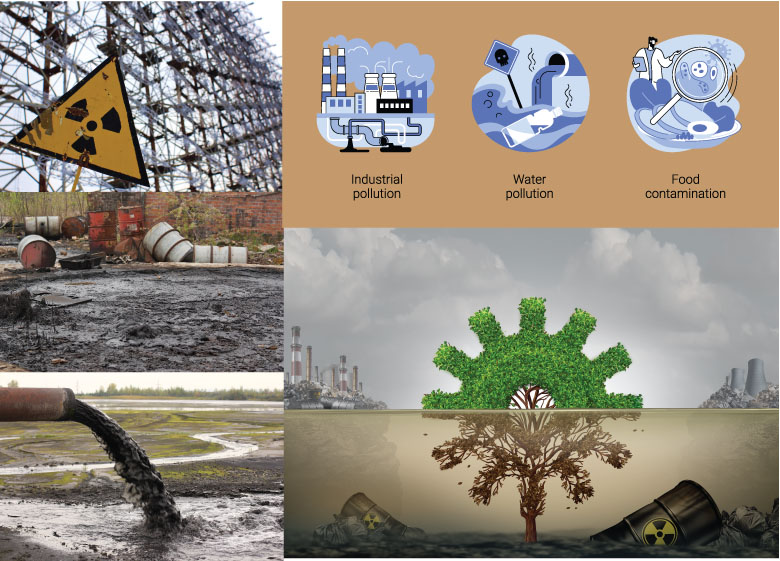
As we go about our daily routines, we may not realise that the very ground we tread upon can harbour unseen dangers that pose risks to both our health and the environment.
In this blog, we’ll discuss the common questions surrounding contaminated land and shed light on its profound implications. Whether you are an environmental enthusiast, a concerned citizen, or simply seeking to expand your knowledge of contaminated land, you’ve arrived at the right place.
What is Contaminated Land?
Contaminated land refers to land that contains foreign substances (known as contamination) either within or beneath it, posing an actual or potential threat to human health or the environment.
Across the United Kingdom, there are numerous locations where land has been contaminated due to various human activities such as industrial operations, chemical and oil spills, and the burial of waste.
Types of Contaminated Land
Legally, land is considered "contaminated land" if substances pose significant harm to people, property, protected species, cause significant pollution to surface or groundwater, or harm people through radioactivity.
Contaminated land might have had prior usage as a:
- Factory
- Mine
- Steel mill
- Refinery
- Landfill
Special Sites
Designated as "special sites," certain contaminated lands fall into this category if they meet the following criteria:
- If it significantly impacts drinking water, surface waters, or crucial groundwater sources.
- Has been or is currently used for specific industrial activities like oil refining or explosives manufacturing.
- Are subject to regulation through permits issued under integrated pollution control or pollution prevention and control regimes.
- Have been utilised for the disposal of waste acid tars.
- Are owned or occupied by the Ministry of Defence.
- Are contaminated by radioactivity.
- Are designated as nuclear sites.
Why Worry About Contaminated Land?
Contaminated land can have various negative impacts on the environment, human health, and socio-economic factors. Here are some reasons why it is important to be cautious of contaminated land:
- Contaminated land can pose risks to individuals using the site and can impact plant growth.
- Exposure to contaminants can occur through inhalation of dust or gases, direct contact with contaminated soil and dust, or consumption of crops grown on the land.
- Liquid pollution draining from contaminated land can contaminate groundwater (an important drinking water source) and bodies of water such as rivers or ponds.
- Certain types of contamination can cause damage to buildings and underground infrastructure like water pipes, while others may present a risk of explosion or fire.
How is Contaminated Land Identified?
Local authorities have a legal obligation under the Environmental Protection Act 1990 to identify contaminated land in their area.
When assessing land for contamination, a risk assessment is conducted to determine if there is a significant risk to human health or harm to the environment. This assessment considers the following factors:
- Is there a source of contamination? Are there any harmful substances actually present on the site or nearby land?
- Is there a pathway between the source of contamination and the receptor? For example, can people breathe in contaminated dust, come into contact with the soil, or consume vegetables grown in the contaminated soil?
- Is there a receptor, such as people, rivers, or buildings on the site, that could be affected by the presence of contamination?
To classify land as contaminated, all three factors (source, pathway, and receptor) must be present. This is known as a 'pollution linkage' or a 'significant pollution linkage' if the risk is deemed significant.
If there is a source of contamination on the site but no pathway or receptor, then there is no pollution linkage. In such cases, the site is not causing harm and should not be classified as contaminated land.
Dealing with Contaminated Land
If a piece of land is legally designated as "contaminated land," the individual or entity responsible for causing or permitting the contamination is held accountable for its resolution, unless:
- Their identity cannot be determined.
- The local council or environmental agency investigating the matter deems them exempt.
In such cases, the council or agency will determine an alternate party responsible for addressing the contamination. This could be the landowner or the person utilising the land.
Reduce Any Contaminated Land Health Risks with Label Source
Here, at Label Source, we supply a wide range of contaminated land signs to identify hazards or dangers associated with polluted land, and to warn the workforce, contractors or the public.
These contaminated land signs can help to meet requirements under the Environmental Protection Act, Contaminated Land Regulations (2006) England and the 2012 amendment, the Water Act 2003, Contaminated Land Scotland Regulations 2000 and 2005 amendment, and the Welsh Government Statutory Guidance on Contaminated Land.